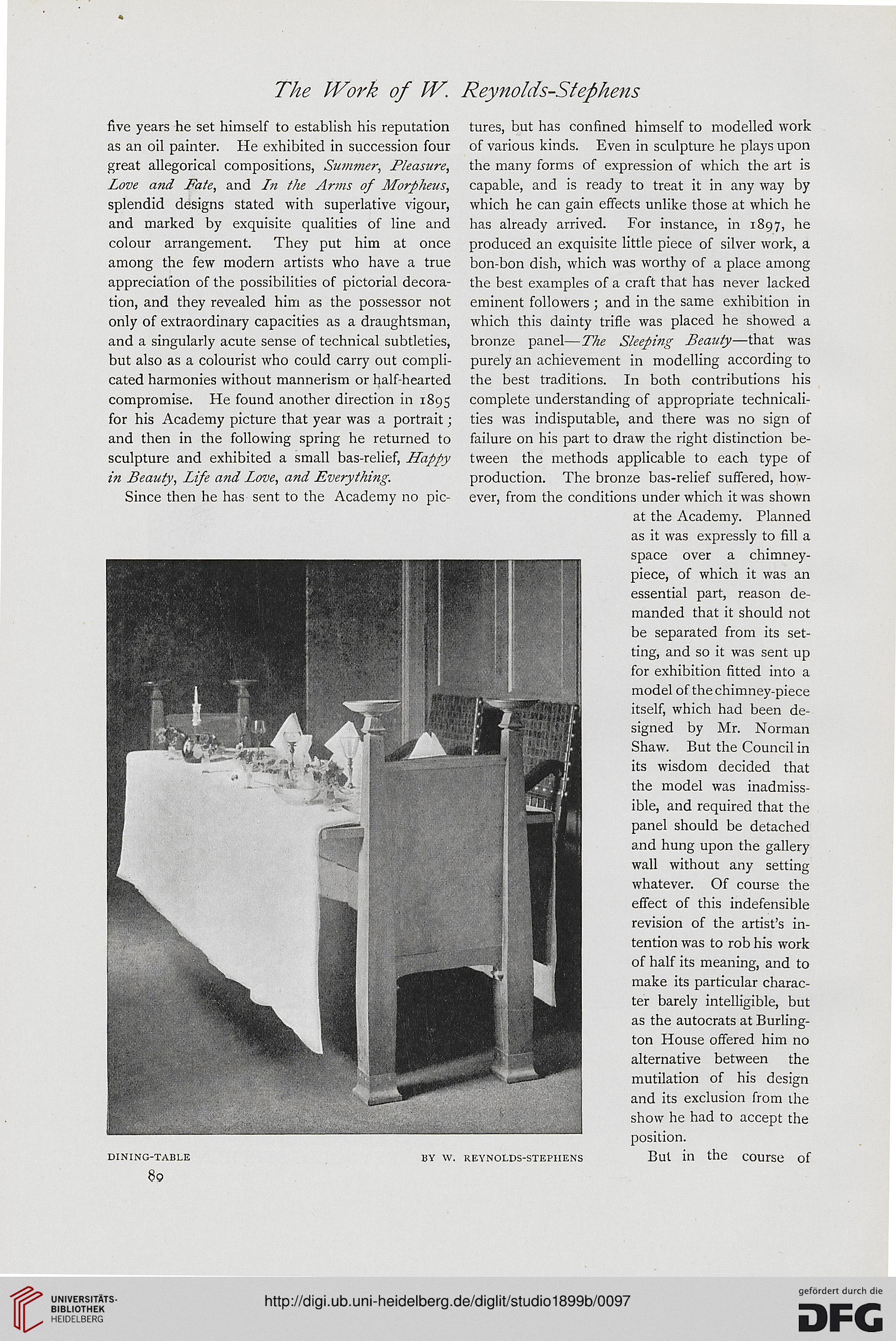The Work of W. Reynolds-Steft hens
five years he set himself to establish his reputation
as an oil painter. He exhibited in succession four
great allegorical compositions, Summer, Pleasure,
Love and Fate, and In the Arms of Morpheus,
splendid designs stated with superlative vigour,
and marked by exquisite qualities of line and
colour arrangement. They put him at once
among the few modern artists who have a true
appreciation of the possibilities of pictorial decora-
tion, and they revealed him as the possessor not
only of extraordinary capacities as a draughtsman,
and a singularly acute sense of technical subtleties,
but also as a colourist who could carry out compli-
cated harmonies without mannerism or half-hearted
compromise. He found another direction in 1895
for his Academy picture that year was a portrait;
and then in the following spring he returned to
sculpture and exhibited a small bas-relief, Happy
in Beauty, Life and Love, and Everything.
Since then he has sent to the Academy no pic-
DINING-TABLE
80
tures, but has confined himself to modelled work
of various kinds. Even in sculpture he plays upon
the many forms of expression of which the art is
capable, and is ready to treat it in any way by
which he can gain effects unlike those at which he
has already arrived. For instance, in 1897, he
produced an exquisite little piece of silver work, a
bon-bon dish, which was worthy of a place among
the best examples of a craft that has never lacked
eminent followers ; and in the same exhibition in
which this dainty trifle was placed he showed a
bronze panel—The Sleeping Beauty—that was
purely an achievement in modelling according to
the best traditions. In both contributions his
complete understanding of appropriate technicali-
ties was indisputable, and there was no sign of
failure on his part to draw the right distinction be-
tween the methods applicable to each type of
production. The bronze bas-relief suffered, how-
ever, from the conditions under which it was shown
at the Academy. Planned
as it was expressly to fill a
space over a chimney-
piece, of which it was an
essential part, reason de-
manded that it should not
be separated from its set-
ting, and so it was sent up
for exhibition fitted into a
model of the chimney-piece
itself, which had been de-
signed by Mr. Norman
Shaw. But the Council in
its wisdom decided that
the model was inadmiss-
ible, and required that the
panel should be detached
and hung upon the gallery
wall without any setting
whatever. Of course the
effect of this indefensible
revision of the artist’s in-
tention was to rob his work
of half its meaning, and to
make its particular charac-
ter barely intelligible, but
as the autocrats at Burling-
ton House offered him no
alternative between the
mutilation of his design
and its exclusion from the
show he had to accept the
position.
But in the course of
BY W. REYNOLDS-STEPIIENS
five years he set himself to establish his reputation
as an oil painter. He exhibited in succession four
great allegorical compositions, Summer, Pleasure,
Love and Fate, and In the Arms of Morpheus,
splendid designs stated with superlative vigour,
and marked by exquisite qualities of line and
colour arrangement. They put him at once
among the few modern artists who have a true
appreciation of the possibilities of pictorial decora-
tion, and they revealed him as the possessor not
only of extraordinary capacities as a draughtsman,
and a singularly acute sense of technical subtleties,
but also as a colourist who could carry out compli-
cated harmonies without mannerism or half-hearted
compromise. He found another direction in 1895
for his Academy picture that year was a portrait;
and then in the following spring he returned to
sculpture and exhibited a small bas-relief, Happy
in Beauty, Life and Love, and Everything.
Since then he has sent to the Academy no pic-
DINING-TABLE
80
tures, but has confined himself to modelled work
of various kinds. Even in sculpture he plays upon
the many forms of expression of which the art is
capable, and is ready to treat it in any way by
which he can gain effects unlike those at which he
has already arrived. For instance, in 1897, he
produced an exquisite little piece of silver work, a
bon-bon dish, which was worthy of a place among
the best examples of a craft that has never lacked
eminent followers ; and in the same exhibition in
which this dainty trifle was placed he showed a
bronze panel—The Sleeping Beauty—that was
purely an achievement in modelling according to
the best traditions. In both contributions his
complete understanding of appropriate technicali-
ties was indisputable, and there was no sign of
failure on his part to draw the right distinction be-
tween the methods applicable to each type of
production. The bronze bas-relief suffered, how-
ever, from the conditions under which it was shown
at the Academy. Planned
as it was expressly to fill a
space over a chimney-
piece, of which it was an
essential part, reason de-
manded that it should not
be separated from its set-
ting, and so it was sent up
for exhibition fitted into a
model of the chimney-piece
itself, which had been de-
signed by Mr. Norman
Shaw. But the Council in
its wisdom decided that
the model was inadmiss-
ible, and required that the
panel should be detached
and hung upon the gallery
wall without any setting
whatever. Of course the
effect of this indefensible
revision of the artist’s in-
tention was to rob his work
of half its meaning, and to
make its particular charac-
ter barely intelligible, but
as the autocrats at Burling-
ton House offered him no
alternative between the
mutilation of his design
and its exclusion from the
show he had to accept the
position.
But in the course of
BY W. REYNOLDS-STEPIIENS




